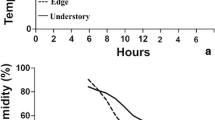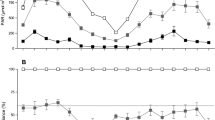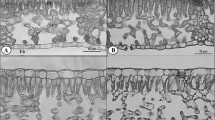Abstract
Leaf orientations and light environments were recorded for 40 juvenile Pseudopanax crassifolius trees growing in New Zealand in a partially shaded, secondary forest environment. Efficiencies of interception of diffuse and direct light by the observed leaf arrangments were calculated relative to those of three hypothetical leaf arrangements. Canopy gaps above the study plants were unevenly distributed with respect to azimuth and elevation above the horizon. Our results indicate that photosynthetically active radiation (PAR) received from the sides is more important than that received from directly above. In 33 of the plants leaf orientation was found to be significantly clustered towards one azimuth. The mean azimuth and the mean angle of declination were different for each plant. Leaves were steeply declined, and oriented towards the largest canopy gap at each site. Steep leaf angles reduced interception of direct and diffuse PAR when compared to interception by plant with a hypothetical horizontal leaf arrangement. When compared to a hypothetical arrangement with steep leaf declination and a uniform azimuth distribution, the observed leaf arrangement increased the efficiency of interception of diffuse PAR, but had a variable effect on the interception of direct PAR. Results indicate that the developing leaves of juvenile P. crassifolius orient towards the strongest sources of diffuse light, regardless of their value as a source of direct light. By maximising diffuse light interception while reducing direct light interception, leaf orientation may be a partial determinant of the types of habitats exploited by this species. This study emphasises the importance of considering diffuse light interception for plants growing in partially shaded environments.
Similar content being viewed by others
References
Allan HH (1961) Flora of New Zealand, vol 1. Government Printer, Wellington
Anderson MC (1964) Studies of the woodland light climate. II. Seasonal variation in the light climate. J Ecol 52:643–663
Canham DD, Denslow JS, Platt WJ, Runkle JR, Spies TA, White PS (1990) Light regimes beneath closed canopies and tree-fall gaps in temperate and tropical forests. Can J For Res 20:620–631
Chazdon RL (1985) Leaf display, canopy structure, and light interception of two understory palm species. Am J Bot 72:1493–1502
Chazdon RL (1986) Light variation and carbon gain in rain forest understorey palms. J Ecol 74:995–1012
Chazdon RL (1988) Sunflecks and their importance to forest understory plants. Adv Ecol Res 18:1–63
Chazdon RL, Fetcher N (1984) Photosynthetic light environments in a lowland tropical rain forest in Costa Rica. J Ecol 72:553–564
Chazdon RL, Field CB (1987) Photographic estimation of photosynthetically active radiation:evaluation of a computerized technique. Oecologia 73:525–532
Chazdon RL, Pearcy RW (1986) Photosynthetic responses to light variation in rainforest species. II. Carbon gain and photosynthetic efficiency during lightflecks. Oecologia 69:524–531
Chazdon RL, Williams K, Field CB (1988) Interactions between crown structure and light environment in five rain forest Piper species. Am J Bot 75:1459–1471
Clearwater MJ (1993) Comparative development and physiology of the leaves of juvenile and adult lancewood (Pseudopannax crassifolius (Cunn.) C. Kock). MSc Thesis, University of Auckland
Clearwater MJ, Gould KS (1994) Comparative leaf development of juvenile and adult Pseudopanax crassifolius. Can J Bot 72:658–670
Comstock JP, Mahall BE (1985) Drought and changes in leaf orientation for two California chaparral shrubs: Ceanothus megacarpus and Ceanothus crassifolius. Oecologia 65:531–535
Denyer K, Cutting M, Campbell G, Hilton M (1993) Waitakere Ecological District, Survey report for the Protected Natural Areas Programme. Auckland Regional Coucil, Auckland
Ehleringer JR, Werk KS (1986) Modifications of solar-radiation absorption patterns and implications for carbon gain at the leaf level. In: Givnish TJ (ed) On the economy of plant form and function. Cambridge University Press, Cambridge, pp 57–82
Gamon JA, Pearcy RW (1989) Leaf movement, stress avoidance and photosynthesis in Vitis californica. Oecologia 79:475–481
Gay LW, Knoerr KR, Braaten MO (1971) Solar radiation variability on the floor of a pine plantation. Agric Meteorol 8:39–50
Givnish TJ (1988) Adaptation to sun and shade: A whole-plant perspective. Aust J Plant Physiol 15:63–92
Goldstone AJ (1981) A study of the impact of reservoir development on indigenous forest. MSc thesis, University of Auckland
Gould KS (1993) Leaf heteroblasty in Pseudopanax crassifolius: Functional significance of leaf morphology and anatomy. Ann Bot 71:61–70
Grace J (1971) The directional distribution of light in natural and controlled environment conditions. J Appl Ecol 8:155–165
Hutchison BA, Matt DR (1976) Beam enrichment of diffuse radiation in a deciduous forest. Agric Meteorol 17:93–100
Hutchison BA, Matt DR, McMillen RT (1980) Effect of sky brightness distribution upon penetration of diffuse radiation through canopy gaps in a deciduous forest. Agric Meteorol 22:137–147
Iqbal M (1983) An introduction to solar radiation. Academic Press, Toronto
Jurik TW, Zhang H, Pleasants JM (1990) Ecophysiological consequences of non-random leaf orientation in the prairie compass plant, Silphium laciniatum. Oecologia 82:180–186
Lovelock CE, Clough BF (1992) Influence of solar radiation and leaf angle on leaf xanthophyll concentrations in mangroves. Oecologia 91:518–525
McMillen GG, McClendon JH (1979) Leaf angle: an adaptive feature of sun and shade leaves. Bot Gaz 140:437–442
Medina E, Sobrado M, Herrera R (1978) Significance of leaf orientation for leaf temperature in an Amazonian sclerophyll vegetation. Rad Environ Biophys 15:131–140
Norman JM, Campbell GS (1989) Canopy structure. In: Pearcy RW, Ehleringer JR, Mooney HA, Rundel PW (eds) Plant physiological ecology: field methods and instrumentation. Chapman and Hall, London, pp 301–325
Oberbauer SF, Clark DB, Clark DC, Rich PM, Vega G (1993) Light environment, gas exchange, and annual growth of spalings of three species of rain forest trees in Costa Rica. J Trop Ecol 9:511–523
Pearce RB, Brown RH, Blaser RE (1967) Photosynthesis in plant communities as influenced by leaf angle. Crop Sci 7:321–324
Pearcy RW (1989) Radiation and light measurements. In: Pearcy RW, Ehleringer JR, Mooney HA, Rundel PW (eds) Plant physiological ecology: field methods and instrumentation. Chapman and Hall, London, pp 97–116
Philipson WR (1965) The New Zealand genera of the Araliaceae. NZ J Bot 3:333–341
Philipson WR (1971) Shoot differentiation in the Araliaceae of New Zealand. J Indian Bot Soc 50A:188–195
Pons TL, Pearcy RW (1992) Photosynthesis in flashing light in soybean leaves grown in different conditions.2. Lightfleck utilization efficiency. Plant Cell Environ 15:577–584
Poorter L, Oberbauer SF (1993) Photosynthetic induction responses of two rainforest tree species in relation to light environment. Oecologia 96:193–199
Poulson TL, Platt WJ (1989) Gap light regimes influence canopy tree diversity. Ecology 70:553–555
Prichard JM, Forseth IN (1988) Rapid leaf movement, microclimate and water relations of two temperate legumes in three contrasting habitats. Am J Bot 75:1201–1211
Soper K (1957) Comparative morphology of the New Zealand pecies of Pseudopanax and Nothopanax. Trans R Soc NZ 84:748–755
Tinocoojanguren C, Pearcy RW (1993) Stomatal dynamics and its inportance to carbon gain in two rainforest Piper species. 1. VPD effects on the transient stomatal response to lightflecks. Oecologia 94:388–394
Warren Wilson J (1981) Analysis of light interception by single plants. Ann Bot 48:501–505
Wayne PM, Bazzaz FA (1993) Morning vs. afternoon sun patches in experimental forest gaps: consequenes of temporal incongruency of resources to birch regeneration. Oecologia 94:235–243
Werk KS, Ehleringer J (1984) Non-random leaf orientation in Lactuca serriola L. Plant Cell Environ 7:81–87
Werk KS, Ehleringer J (1985) Photosynthetic characteristics of Lactuca serriola L. Plant Cell Environ 8:345–350
Werk KS, Ehleringer J (1986) Field water relations of a compass plant, Lactuca serriola L. Plant Cell Environ 9:681–683
Zar JH (1984) Biostatistical anaysis, 2nd edn. Prentice Hall, Englewood Cliffs, New Jersey
Zhang H, Pleasants JM, Jurik TW (1991) Development of leaf orientation in the prairie compass plant, Silphium laciniatum L. Bull Torrey Bot Club 118:33–42
Author information
Authors and Affiliations
Rights and permissions
About this article
Cite this article
Clearwater, M.J., Gould, K.S. Leaf orientation and light interception by juvenile Pseudopanax crassifolius(Cunn.) C. Koch in a partially shaded forest environment. Oecologia 104, 363–371 (1995). https://doi.org/10.1007/BF00328372
Received:
Accepted:
Issue Date:
DOI: https://doi.org/10.1007/BF00328372




